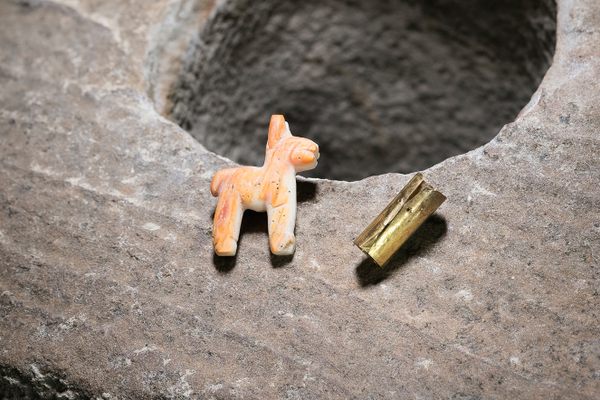The Curious History of Animals Interfering With the Tour de France
The llamas are only the latest animal to disrupt the world’s most famous bicycle race.

Look out for crossing llamas. (Photo: AHLN/CC BY-2.0)
Today, this year’s Tour de France competitors faced stage eight of the 12-day, 21-stage bicycle race, with riders travelling from Pau to Luchon in the Pyrenees mountain range. The stage includes this year’s first Hors Catégorie (“beyond categorization”) climb within the legendary Col du Tourmalet, the highest mountain pass in the Tour de France. HC climbs are considered the most difficult in bicycle racing, and the Col du Tourmalet is notorious in the history of the Tour de France for its difficulty.
According to a 2010 article in The Guardian, when the pass was first used in the race in 1910, the tour’s winner—Octave Lapize—was quick to voice his opinion of the Tour’s decision to incorporate mountain climbs:
As Lapize crossed the summit of the next pass, the Col d’Aubisque, he hurled a famous imprecation at the commissaires. “You are all assassins,” he shouted with what remained of his strength. “No human being should be put through an ordeal like this. That’s enough for me.”
However, the challenges posed by the mountain climbs weren’t the most-talked-about factors leading up to today’s stage. Instead, enthusiasts were sounding the alarm about about another potential roadblock for riders: llamas.

The llamas on the road. (Photo: Joel Adages/Facebook)
The internet’s favorite camelids were threatening to grab the spotlight yet again, as Huffington Post France uncovered evidence that some llamas in the area have developed an affinity for the paved mountain pass used in the Tour. Local Joël Adages posted pictures of a substantial llama gathering on the Col du Tourmalet about a week ago, wryly noting the potential conflict with the caption “The first Tour de France spectators are already in place.”
As Adages explained to HuffPo, the llamas didn’t actually travel from their native South America just to watch the race. In reality, an area campsite operator had purchased the llamas for his campsite in La Mongie, a village located below the Col du Tourmalet. The operator planned to use the llamas as groundskeepers, allowing them to graze freely at the campsite during the winter. But, due to legal restrictions around French llama possession, the owner had to find alternate housing for the llamas during summer, and made arrangements for them to graze amongst other livestock on the Col du Tourmalet from May to October each year.
The llamas’ apparent fondness for the paved road is a simple matter of temperature regulation—the pavement retains heat from the sun longer than unpaved ground, and the llamas made use of the road when the chilly fog shown in the pictures rolled in.
You might think the noise and crowds surrounding the world’s most famous bicycle race would deter livestock from wandering near, but the jokes about potential llama interference weren’t unfounded. In 2014, a tiny white dog escaped the grasp of his owner and darted into the road as the peloton began the final sprint to the end of the stage two. Fortunately, the dog managed to avoid 100 bikes traveling over 30mph. Similarly, in 2007 a golden retriever collided with German rider Marcus Burghardt, flipping his bike during one of the most grueling stages in that year’s route (the dog was unharmed and Burghardt sustained only minor injuries). Is there video? Of course there’s video.
But most relevant are the events of the 2010 Tour de France, which featured the Col du Tourmalet as the race’s final stage in honor of the 100th anniversary of its first inclusion in the race route. Just as the peloton approached, a flock of sheep unanimously decided to cross the pass, bringing the riders to a near-standstill and inspiring some truly atrocious puns from sports journalists. “Assassins,” indeed.
Fortunately — or unfortunately, depending on your feelings about llamas and/or bicycle races—the llamas steered clear of the pass today and stage 8 proceeded without interruption. Britain’s Team Sky, led by Chris Froome, claimed victory for the day and the yellow jersey, completing the stage with an astonishing 60mph descent to the finish line. This year’s race hasn’t been without mishaps, though; just yesterday, a spectator caused an inflatable banner to come crashing down on riders as they crossed the stage 7 finish line.









Follow us on Twitter to get the latest on the world's hidden wonders.
Like us on Facebook to get the latest on the world's hidden wonders.
Follow us on Twitter Like us on Facebook